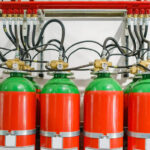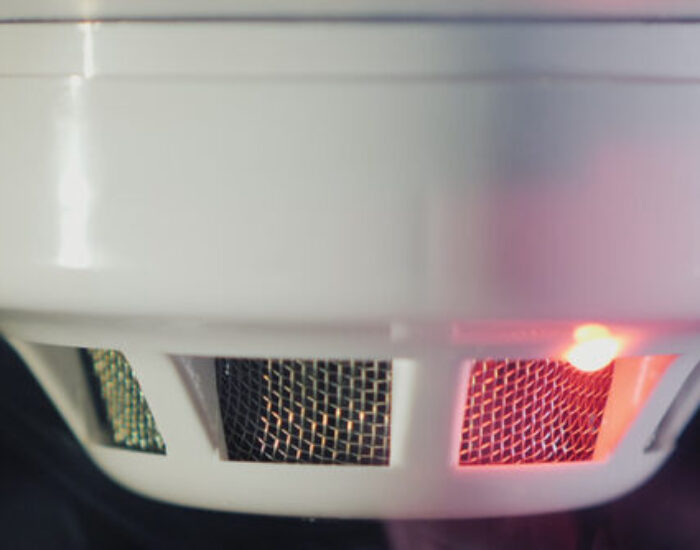What is a Clean Agent Fire Suppression System?
Traditional fire suppression systems use water sprinklers attached to ceilings or a carbon dioxide-based fire suppression system meant soley for unoccupied buildings. With many facilities now equipped with digital or electronic equipment, the risk of water damage is too high to rely on sprinkler systems. For buildings housing sensitive data storage servers and other computerized devices, the best alternative to water sprinkler or CO2 systems is a clean agent fire suppression system.

FAQs About Different Types of Clean Agent Fire Suppression Systems
How Does a Clean Agent Fire Suppression System Work?
Composed of smoke detectors, notification devices and a control panel, a clean agent fire suppression system releases inert gases when smoke detectors signal the control panel that it has “sensed” a rise in air temperature. In addition to extinguishing fires quickly and efficiently, clean agent fire suppression systems do not use water so they cannot damage digital equipment, valuable artwork, data servers and another items vulnerable to destruction by water. Residents or employees of buildings protected by clean agent fire suppression systems are often given notification devices that alert them before clean agents are released.
What is the FM 200 Clean Agent Fire Suppression System?
The clean agent compound FM-200 contains hydrogen, fluorine and carbon. With the ability to reach an extinguishing level in a few seconds, FM-200 is considered to be the fastest clean agent system available. Benefits of the FM 200 fire suppression system include:
- Eliminates the need to pay for expensive water clean-up after a fire
- Provides fire protection for electronic equipment and industrial machinery that requires flammable liquids to operate
- Is safe to use around humans as long as guidelines established by the U.S. EPA are followed
- Extinguishes fires by rapidly absorbing fire-produced heat
What is the Novec 1230 Clean Agent Fire Suppression System?
Similar to FM 200 clean agent fire suppression systems, Novec 1230 also extinguishes fires quickly and efficiently and is safe to use in data processing centers, industrial facilities and occupied buildings. The primary difference between the Novec 1230 and the FM 200 is that the Novec 1230 clean agent is a viable alternative to extinguishing agents like hydrofluorocarbon that can’t be included in an HFC phaseout.
Benefits of the Novec 1230 clean agent fire suppression system include:
- Halon systems may be adapted to use Novec 1230 clean agent fluid instead of halon
- Zero ozone depleting potential
- Is eliminated from the atmosphere within five days of dispersal
- Has minimal storage space requirements
- Submission for inclusion in CEN and ISO design standards is currently underway
What is an Inert Gas Clean Agent Fire Suppression System?
 Instead of removing heat, inert gas systems decrease oxygen levels in areas where fires have started. Inert nitrogen and argon gas molecules dissolve oxygen molecules to prevent fires from being stoked by oxygen. Additionally, individual inert gas clean agent fire suppression systems are developed specifically to reduce oxygen to a predetermined level for maximum fire stoppage.
Instead of removing heat, inert gas systems decrease oxygen levels in areas where fires have started. Inert nitrogen and argon gas molecules dissolve oxygen molecules to prevent fires from being stoked by oxygen. Additionally, individual inert gas clean agent fire suppression systems are developed specifically to reduce oxygen to a predetermined level for maximum fire stoppage.
Benefits of inert gas systems include:
- Noncorrosive–safe to use around brass, steel, copper, stainless steel and plastic materials
- Argon and nitrogen will never be designated as hazardous waste. Both gases are found in abundant levels in the Earth’s atmosphere
- Equipped with an efficient, valve assembly mechanism that rapidly releases inert gases at a safe flow rate
- Requires less expensive, low pressure piping that extends from nozzle to container
- Requires smaller venting areas than other clean agent fire suppression systems
What Other Different Types of Clean Agent Fire Suppression Systems are Available?
While carbon dioxide fire suppression systems remain popular, they cannot be used in buildings where people live and work. Carbon dioxide suffocates fires by removing large amounts of oxygen from the room. For this reason, carbon dioxide fire suppression systems should only be implemented in unoccupied or minimally occupied buildings with plenty of easy-to-access exits.
Commercial kitchens cannot use FM200, Novec 1230 or inert gas clean agent fire suppression systems due to potential contamination of food. Instead, most food business kitchens rely on chemical foam suppression systems to put out fires. Chemical foam for this purpose contains potassium carbonate and other agents that can safely extinguish fires around food without fear of contaminating edible items.
What is Involved with Installing Different Types of Clean Agent Fire Suppression System?
During your free consultation with us, we will discuss things like:
- Ensuring spaces protected by a clean agent fire suppression system are properly sealed to prevent gases from escaping
- Possible need for doors not usually closed to be outfitted with special release/closure devices operated automatically by the control panel
- Possible need to install low-voltage-controlled dampers to shut off exhaust or supply air flow when clean agents are discharged
- Establishing appropriate locations for control panels that can be surface mounted or flush mounted
- Establishing appropriate locations for clean agent containers
Which Clean Agent Fire Suppression System Should Protect My Business?
We can help you determine which fire suppression system is best suited to protect your business by performing a professional evaluation of your company’s building, materials contained in the building and areas of high fire risks. For over 40 years, WFX has earned a stellar reputation for providing superior, state-of-the-art protection against theft, security threats, property threats and fires. Please call WFX +1 (855) 939-1978 to schedule a free consultation appointment or use our convenient email submission form to tell us about your fire protection needs and concerns.





